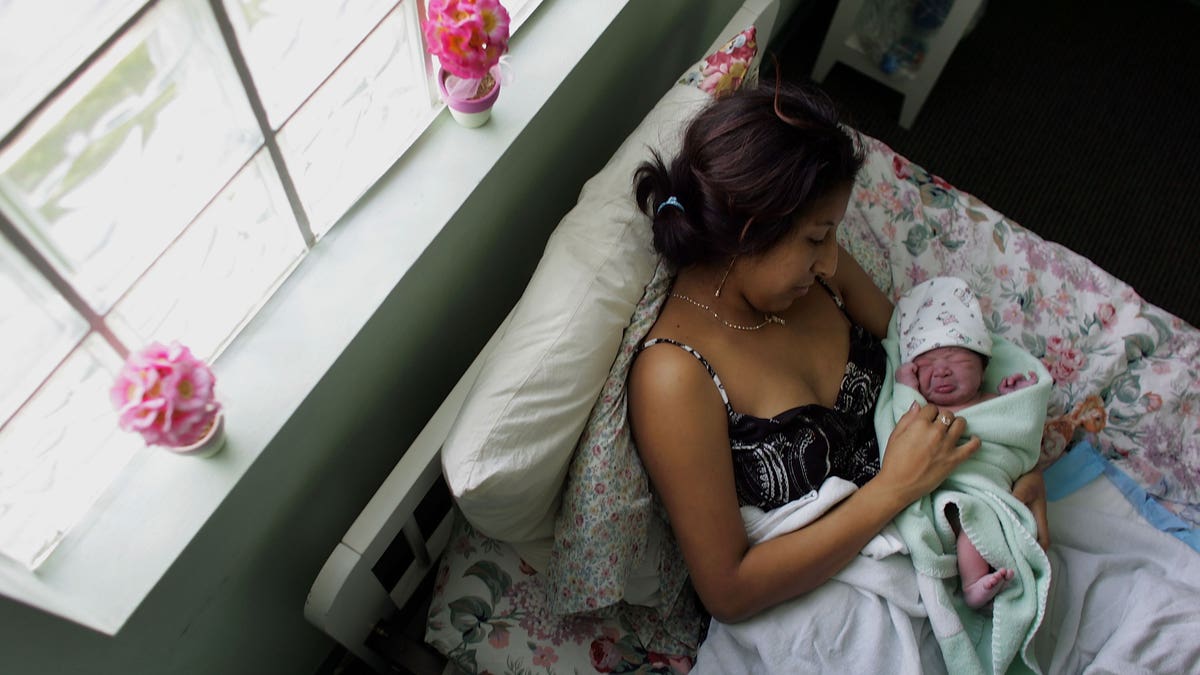
FLORIDA CITY, FL- OCTOBER 16: Yailin Melissa Turcios, who was about 20 minutes prior, lies in the arms of her mother, Rosa Turcios, on a bed at the Birthing Center of South Florida October 16, 2006 in Florida City, Florida. (Photo by Joe Raedle/Getty Images) (2006 Getty Images)
For the first time, minorities make up a majority of babies in the U.S., part of a sweeping race change and a growing age divide between mostly white, older Americans and predominantly minority youths that is set to reshape everything from American culture to government policies.
The findings, based on the latest government data, offer a preview of final 2010 census results being released this summer that provide detailed breakdowns by age, race and householder relationships.
Demographers say the numbers provide the clearest confirmation yet of a changing social order, one in which racial and ethnic minorities will become the U.S. majority by midcentury.
"We're moving toward an acknowledgment that we're living in a different world than the 1950s," said Laura Speer, coordinator of the Kids Count project for the Baltimore-based Annie E. Casey Foundation.
"It's clear the younger generation is very demographically different from the elderly, something to keep in mind as politics plays out on how programs for the elderly get supported," she said. "It's critical that children are able to grow to compete internationally and keep state economies rolling."
Currently, non-Hispanic whites make up just under half of all children 3 years old, which is the youngest age group shown in the Census Bureau's October 2009 annual survey, its most recent. In 1990, more than 60 percent of children in that age group were white.
William H. Frey, a demographer at the Brookings Institution who analyzed the data, said figures in the 2009 survey can sometimes be inexact compared with the 2010 census, which queries the entire nation. But he said when factoring in the 2010 data released so far, minorities outnumber whites among babies under age 2.
The preliminary figures are based on an analysis of the Current Population Survey as well as the 2009 American Community Survey, which sampled 3 million U.S. households to determine that whites made up 51 percent of babies younger than 2. After taking into account a larger-than-expected jump in the minority child population in the 2010 census, the share of white babies falls below 50 percent.
Twelve states and the District of Columbia now have white populations below 50 percent among children under age 5 Hawaii, California, New Mexico, Texas, Arizona, Nevada, Florida, Maryland, Georgia, New Jersey, New York and Mississippi. That's up from six states and the District of Columbia in 2000.
At current growth rates, seven more states could flip to "minority-majority" status among small children in the next decade: Illinois, North Carolina, Virginia, Colorado, Connecticut, South Carolina and Delaware.
By contrast, whites make up the vast majority of older Americans 80 percent of seniors 65 and older and roughly 73 percent of people ages 45-64. Many states with high percentages of white seniors also have particularly large shares of minority children, including Arizona, Nevada, California, Texas and Florida.
"The recent emergence of this cultural generation gap in states with fast growth of young Hispanics has spurred heated discussions of immigration and the use of government services," Frey said. "But the new census, which will show a minority majority of our youngest Americans, makes plain that our future labor force is absolutely dependent on our ability to integrate and educate a new diverse child population."
Kenneth Johnson, a sociology professor and senior demographer at the University of New Hampshire, noted that much of the race change is being driven by increases in younger Hispanic women having more children than do white women, who have lower birth rates and as a group are moving beyond their prime childbearing years.
Because minority births are driving the rapid changes in the population, "any institution that touches or is impacted by children will be the first to feel the impact," Johnson said, citing as an example child and maternal health care that will have to be attentive to minorities' needs.
Female-headed households make up a 19 percent share among Hispanics and 9 percent each for whites and Asians.
Other findings:
The number of multigenerational households surged 30 percent in the last decade. Composed of families with grandparents, parents and children, these households were most common among Hispanics, particularly in California, Maryland, Illinois, Nevada and Texas, all states where they represented nearly 1 in 10 Latino households. An analysis by the San Jose Mercury News found that in certain California neighborhoods, that number was as high as 1 in 5.
Minorities comprise a majority of renters in 10 states, plus the District of Columbia Hawaii, Texas, California, Georgia, Maryland, New Mexico, Mississippi, New Jersey, Louisiana and New York.
Tony Perkins, president of the Washington, D.C.-based Family Research Council, a conservative interest group, emphasized the economic impact of the decline of traditional families, noting that single-parent families are often the most dependent on government assistance.
"The decline of the traditional family will have to correct itself if we are to continue as a society," Perkins said, citing a responsibility of individuals and churches. "We don't need another dose of big government, but a new Hippocratic oath of `do no harm' that doesn't interfere with family formation or seek to redefine family."
Follow us on twitter.com/foxnewslatino
Like us at facebook.com/foxnewslatino




















